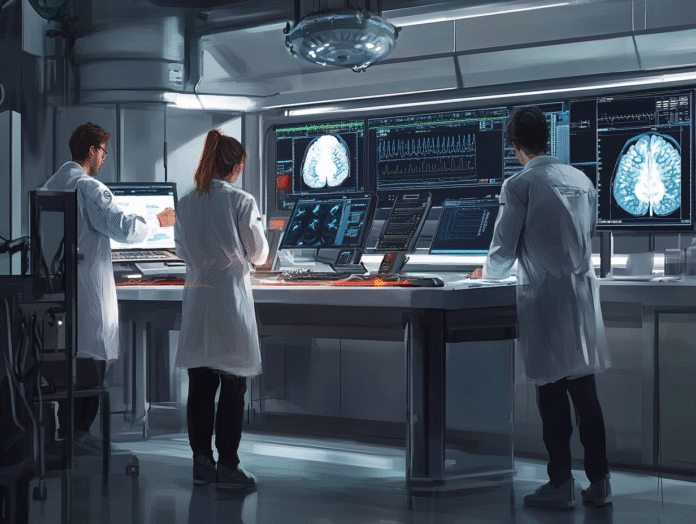Artificial Intelligence (AI) has transformed the medical imaging industry, offering powerful tools for diagnosis, treatment planning, and workflow optimization. As of 2025, AI’s integration with imaging platforms continues to accelerate, driving innovations that promise to reshape healthcare delivery. This essay explores the current state of AI in medical imaging, the anticipated developments by 2025, and expert insights into this rapidly evolving field.
Current State of AI in Medical Imaging
AI has made significant inroads into medical imaging by enhancing diagnostic accuracy, increasing efficiency, and reducing workload for radiologists and clinicians. Technologies such as deep learning and neural networks enable AI algorithms to process large datasets and identify patterns imperceptible to the human eye. Key applications include:
- Automated Diagnosis: AI-driven platforms like Aidoc and Zebra Medical Vision analyze medical images for abnormalities such as tumors, fractures, or embolisms.
- Image Enhancement: AI improves image quality by reducing noise and artifacts in MRI and CT scans, enabling clearer visualization.
- Workflow Optimization: AI-powered tools streamline administrative tasks, including image prioritization, reporting, and follow-ups.
A survey by the American College of Radiology (ACR) in 2023 found that 62% of radiologists already used AI in some capacity, with applications ranging from anomaly detection to workflow integration. These advancements demonstrate AI’s potential to alleviate radiology bottlenecks and improve patient outcomes.
Current State of AI in Medical Imaging
AI has made significant inroads into medical imaging by enhancing diagnostic accuracy, increasing efficiency, and reducing workload for radiologists and clinicians. Technologies such as deep learning and neural networks enable AI algorithms to process large datasets and identify patterns that are imperceptible to the human eye. Key applications include:
- Automated Diagnosis: AI-driven platforms like Aidoc and Zebra Medical Vision analyze medical images for abnormalities such as tumors, fractures, or embolisms.
- Image Enhancement: AI improves image quality by reducing noise and artifacts in MRI and CT scans, enabling clearer visualization.
- Workflow Optimization: AI-powered tools streamline administrative tasks, including image prioritization, reporting, and follow-ups.
A survey by the American College of Radiology (ACR) in 2023 found that 62% of radiologists already used AI in some capacity, with applications ranging from anomaly detection to workflow integration. These advancements demonstrate AI’s potential to alleviate radiology bottlenecks and improve patient outcomes.
AI and Imaging Platforms: Trends for 2025
The future of AI in medical imaging is shaped by advancements in hardware, software, and regulatory frameworks. Here are the key trends expected to define the industry in 2025:
- Federated Learning and Privacy: Federated learning allows AI models to train across decentralized datasets without compromising patient privacy. This technique addresses data security concerns while enabling collaboration among healthcare providers.
- Multi-Modality Imaging: AI platforms increasingly integrate data from multiple imaging modalities (e.g., X-ray, CT, and ultrasound) to provide comprehensive diagnostic insights. For instance, combining PET and CT scan data enhances precision in detecting metastatic cancers.
- Personalized Medicine: AI will facilitate the development of personalized diagnostic and treatment plans by analyzing patient-specific imaging data alongside genetic, lifestyle, and clinical information.
- Real-Time Decision Support: Advanced AI algorithms will offer real-time decision support during surgeries and interventions, enhancing procedural precision and reducing risks.
- Regulatory and Ethical Advances: Regulatory bodies like the FDA and EMA must establish clearer guidelines for AI-driven medical devices, ensuring safety and efficacy. Ethical considerations will also gain prominence, including bias mitigation and algorithm transparency.
Expert Opinions on AI in Medical Imaging
Several industry leaders and experts have shared valuable insights on the role of AI in imaging platforms. Their perspectives underscore the transformative potential of AI in healthcare:
- Dr. Curtis Langlotz (Stanford University): “AI is not here to replace radiologists but to augment their capabilities. By reducing mundane tasks, we enable radiologists to focus on complex cases and deliver more personalized care.” (Source: Stanford Medicine)
- Geoffrey Hinton (AI Pioneer): “Medical imaging is one of the most promising fields for deep learning applications. The ability to analyze pixel-level details with unprecedented accuracy opens new frontiers for diagnosis.” (Source: The Verge)
- Dr. Elad Benjamin (General Manager, Philips AI): “AI in imaging is evolving from point solutions to end-to-end platforms that cover the entire clinical workflow, from image acquisition to actionable insights.” (Source: Philips Healthcare)
Challenges and Limitations
Despite its immense promise, AI in medical imaging faces several challenges:
- Data Quality and Bias: AI models rely on high-quality datasets for training. Bias in these datasets can lead to disparities in diagnostic accuracy, particularly for underrepresented populations.
- Integration Complexity: Integrating AI tools with existing hospital infrastructure, such as PACS (Picture Archiving and Communication Systems), requires significant technical and financial investments.
- Regulatory Hurdles: The lack of standardized regulatory frameworks slows the deployment of AI-based medical devices. Navigating approval processes remains a significant barrier.
- Trust and Adoption: Clinicians may resist adopting AI solutions due to accuracy, reliability, and job displacement concerns. Building trust through education and transparent validation processes is crucial.
What Lies Ahead for AI in Medical Imaging?
Looking forward to 2025 and beyond, AI is poised to redefine the medical imaging landscape. Key advancements include:
- AI-Powered Screening Programs: Governments and healthcare providers will adopt AI-driven screening initiatives to detect diseases such as cancer, tuberculosis, and cardiovascular conditions early.
- Global Collaboration: Initiatives like the European Health Data Space will foster cross-border data sharing, enabling AI models to learn from diverse datasets and improve global healthcare standards.
- AI-Assisted Radiology Training: Educational platforms will incorporate AI tools to train the next generation of radiologists, emphasizing the importance of human-AI collaboration.
- Edge Computing in Imaging: Advances in edge computing will enable real-time image analysis at the point of care, reducing latency and enhancing decision-making in critical settings.
- Theranostic Imaging: AI will enable theranostic imaging—combining diagnostics with therapeutics—to deliver targeted treatments based on imaging data.
A final note
As AI continues to evolve, its impact on medical imaging will expand, offering new diagnostic, treatment, and patient care capabilities. Integrating federated learning, multi-modality imaging, and real-time decision support highlights AI’s potential to address pressing healthcare challenges. However, overcoming barriers such as data bias, regulatory complexities, and clinician skepticism is essential to realizing these benefits.
The insights of experts like Dr. Curtis Langlotz, Geoffrey Hinton, and Dr. Elad Benjamin reinforce the importance of collaboration between AI technologies and human expertise. By fostering innovation and ethical practices, the healthcare industry can harness AI to deliver better outcomes, improve accessibility, and shape a more sustainable future for medical imaging.
Researched and written by:
Samantha Cohen – Co-editor
Tech Online News
Peter Jonathan Wilcheck – Co-editor
Tech Online News
Serge Archaumbeault – Co-editor
Tech Online News
Post Disclaimer
The information provided in our posts or blogs are for educational and informative purposes only. We do not guarantee the accuracy, completeness or suitability of the information. We do not provide financial or investment advice. Readers should always seek professional advice before making any financial or investment decisions based on the information provided in our content. We will not be held responsible for any losses, damages or consequences that may arise from relying on the information provided in our content.



